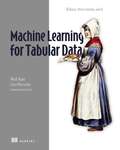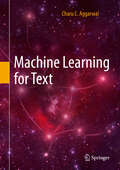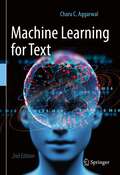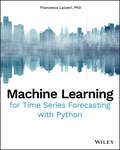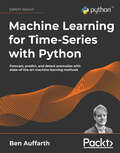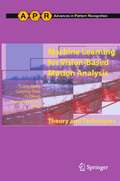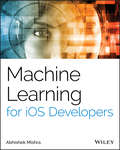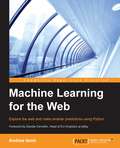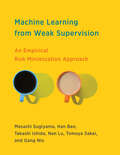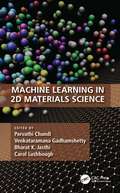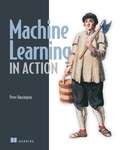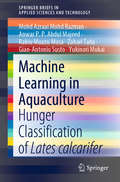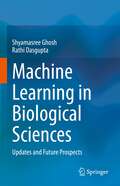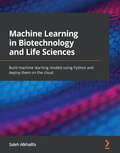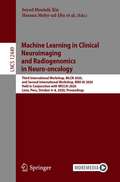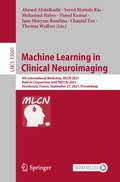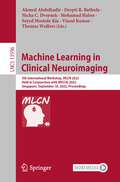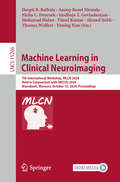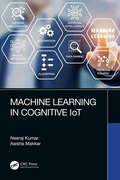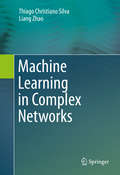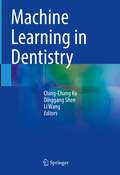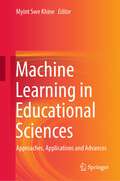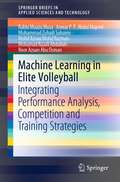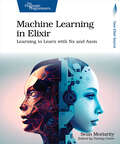- Table View
- List View
Machine Learning for Tabular Data
by Mark Ryan Luca MassaronBusiness runs on tabular data in databases, spreadsheets, and logs. Crunch that data using deep learning, gradient boosting, and other machine learning techniques.Machine Learning for Tabular Data teaches you to train insightful machine learning models on common tabular business data sources such as spreadsheets, databases, and logs. You&’ll discover how to use XGBoost and LightGBM on tabular data, optimize deep learning libraries like TensorFlow and PyTorch for tabular data, and use cloud tools like Vertex AI to create an automated MLOps pipeline. Machine Learning for Tabular Data will teach you how to: • Pick the right machine learning approach for your data • Apply deep learning to tabular data • Deploy tabular machine learning locally and in the cloud • Pipelines to automatically train and maintain a model Machine Learning for Tabular Data covers classic machine learning techniques like gradient boosting, and more contemporary deep learning approaches. By the time you&’re finished, you&’ll be equipped with the skills to apply machine learning to the kinds of data you work with every day. Foreword by Antonio Gulli. About the technology Machine learning can accelerate everyday business chores like account reconciliation, demand forecasting, and customer service automation—not to mention more exotic challenges like fraud detection, predictive maintenance, and personalized marketing. This book shows you how to unlock the vital information stored in spreadsheets, ledgers, databases and other tabular data sources using gradient boosting, deep learning, and generative AI. About the book Machine Learning for Tabular Data delivers practical ML techniques to upgrade every stage of the business data analysis pipeline. In it, you&’ll explore examples like using XGBoost and Keras to predict short-term rental prices, deploying a local ML model with Python and Flask, and streamlining workflows using large language models (LLMs). Along the way, you&’ll learn to make your models both more powerful and more explainable. What's inside • Master XGBoost • Apply deep learning to tabular data • Deploy models locally and in the cloud • Build pipelines to train and maintain models About the reader For readers experienced with Python and the basics of machine learning. About the author Mark Ryan is the AI Lead of the Developer Knowledge Platform at Google. A three-time Kaggle Grandmaster, Luca Massaron is a Google Developer Expert (GDE) in machine learning and AI. He has published 17 other books. Table of Contents Part 1 1 Understanding tabular data 2 Exploring tabular datasets 3 Machine learning vs. deep learning Part 2 4 Classical algorithms for tabular data 5 Decision trees and gradient boosting 6 Advanced feature processing methods 7 An end-to-end example using XGBoost Part 3 8 Getting started with deep learning with tabular data 9 Deep learning best practices 10 Model deployment 11 Building a machine learning pipeline 12 Blending gradient boosting and deep learning A Hyperparameters for classical machine learning models B K-nearest neighbors and support vector machines
Machine Learning for Text
by Charu C. AggarwalText analytics is a field that lies on the interface of information retrieval,machine learning, and natural language processing, and this textbook carefully covers a coherently organized framework drawn from these intersecting topics. The chapters of this textbook is organized into three categories:- Basic algorithms: Chapters 1 through 7 discuss the classical algorithms for machine learning from text such as preprocessing, similarity computation, topic modeling, matrix factorization, clustering, classification, regression, and ensemble analysis.- Domain-sensitive mining: Chapters 8 and 9 discuss the learning methods from text when combined with different domains such as multimedia and the Web. The problem of information retrieval and Web search is also discussed in the context of its relationship with ranking and machine learning methods. - Sequence-centric mining: Chapters 10 through 14 discuss various sequence-centric and natural language applications, such as feature engineering, neural language models, deep learning, text summarization, information extraction, opinion mining, text segmentation, and event detection. This textbook covers machine learning topics for text in detail. Since the coverage is extensive,multiple courses can be offered from the same book, depending on course level. Even though the presentation is text-centric, Chapters 3 to 7 cover machine learning algorithms that are often used indomains beyond text data. Therefore, the book can be used to offer courses not just in text analytics but also from the broader perspective of machine learning (with text as a backdrop). This textbook targets graduate students in computer science, as well as researchers, professors, and industrial practitioners working in these related fields. This textbook is accompanied with a solution manual for classroom teaching.
Machine Learning for Text
by Charu C. AggarwalThis second edition textbook covers a coherently organized framework for text analytics, which integrates material drawn from the intersecting topics of information retrieval, machine learning, and natural language processing. Particular importance is placed on deep learning methods. The chapters of this book span three broad categories:1. Basic algorithms: Chapters 1 through 7 discuss the classical algorithms for text analytics such as preprocessing, similarity computation, topic modeling, matrix factorization, clustering, classification, regression, and ensemble analysis.2. Domain-sensitive learning and information retrieval: Chapters 8 and 9 discuss learning models in heterogeneous settings such as a combination of text with multimedia or Web links. The problem of information retrieval and Web search is also discussed in the context of its relationship with ranking and machine learning methods. 3. Natural language processing: Chapters 10 through 16 discuss various sequence-centric and natural language applications, such as feature engineering, neural language models, deep learning, transformers, pre-trained language models, text summarization, information extraction, knowledge graphs, question answering, opinion mining, text segmentation, and event detection. Compared to the first edition, this second edition textbook (which targets mostly advanced level students majoring in computer science and math) has substantially more material on deep learning and natural language processing. Significant focus is placed on topics like transformers, pre-trained language models, knowledge graphs, and question answering.
Machine Learning for Time Series Forecasting with Python
by Francesca LazzeriLearn how to apply the principles of machine learning to time series modeling with this indispensable resource Machine Learning for Time Series Forecasting with Python is an incisive and straightforward examination of one of the most crucial elements of decision-making in finance, marketing, education, and healthcare: time series modeling. Despite the centrality of time series forecasting, few business analysts are familiar with the power or utility of applying machine learning to time series modeling. Author Francesca Lazzeri, a distinguished machine learning scientist and economist, corrects that deficiency by providing readers with comprehensive and approachable explanation and treatment of the application of machine learning to time series forecasting. Written for readers who have little to no experience in time series forecasting or machine learning, the book comprehensively covers all the topics necessary to: Understand time series forecasting concepts, such as stationarity, horizon, trend, and seasonality Prepare time series data for modeling Evaluate time series forecasting models’ performance and accuracy Understand when to use neural networks instead of traditional time series models in time series forecasting Machine Learning for Time Series Forecasting with Python is full real-world examples, resources and concrete strategies to help readers explore and transform data and develop usable, practical time series forecasts. Perfect for entry-level data scientists, business analysts, developers, and researchers, this book is an invaluable and indispensable guide to the fundamental and advanced concepts of machine learning applied to time series modeling.
Machine Learning for Time-Series with Python: Forecast, predict, and detect anomalies with state-of-the-art machine learning methods
by Ben AuffarthBecome proficient in deriving insights from time-series data and analyzing a model's performanceKey FeaturesExplore popular and modern machine learning methods including the latest online and deep learning algorithmsLearn to increase the accuracy of your predictions by matching the right model with the right problemMaster time-series via real-world case studies on operations management, digital marketing, finance, and healthcareBook DescriptionMachine learning has emerged as a powerful tool to understand hidden complexities in time-series datasets, which frequently need to be analyzed in areas as diverse as healthcare, economics, digital marketing, and social sciences. These datasets are essential for forecasting and predicting outcomes or for detecting anomalies to support informed decision making.This book covers Python basics for time-series and builds your understanding of traditional autoregressive models as well as modern non-parametric models. You will become confident with loading time-series datasets from any source, deep learning models like recurrent neural networks and causal convolutional network models, and gradient boosting with feature engineering.Machine Learning for Time-Series with Python explains the theory behind several useful models and guides you in matching the right model to the right problem. The book also includes real-world case studies covering weather, traffic, biking, and stock market data.By the end of this book, you will be proficient in effectively analyzing time-series datasets with machine learning principles.What you will learnUnderstand the main classes of time-series and learn how to detect outliers and patternsChoose the right method to solve time-series problemsCharacterize seasonal and correlation patterns through autocorrelation and statistical techniquesGet to grips with time-series data visualizationUnderstand classical time-series models like ARMA and ARIMAImplement deep learning models, like Gaussian processes, transformers, and state-of-the-art machine learning modelsBecome familiar with many libraries like Prophet, XGboost, and TensorFlowWho this book is forThis book is ideal for data analysts, data scientists, and Python developers who are looking to perform time-series analysis to effectively predict outcomes. Basic knowledge of the Python language is essential. Familiarity with statistics is desirable.
Machine Learning for Vision-Based Motion Analysis
by Guoying Zhao Liang Wang Li Cheng Matti PietikäinenTechniques of vision-based motion analysis aim to detect, track, identify, and generally understand the behavior of objects in image sequences. With the growth of video data in a wide range of applications from visual surveillance to human-machine interfaces, the ability to automatically analyze and understand object motions from video footage is of increasing importance. Among the latest developments in this field is the application of statistical machine learning algorithms for object tracking, activity modeling, and recognition. Developed from expert contributions to the first and second International Workshop on Machine Learning for Vision-Based Motion Analysis, this important text/reference highlights the latest algorithms and systems for robust and effective vision-based motion understanding from a machine learning perspective. Highlighting the benefits of collaboration between the communities of object motion understanding and machine learning, the book discusses the most active forefronts of research, including current challenges and potential future directions. Topics and features: provides a comprehensive review of the latest developments in vision-based motion analysis, presenting numerous case studies on state-of-the-art learning algorithms; examines algorithms for clustering and segmentation, and manifold learning for dynamical models; describes the theory behind mixed-state statistical models, with a focus on mixed-state Markov models that take into account spatial and temporal interaction; discusses object tracking in surveillance image streams, discriminative multiple target tracking, and guidewire tracking in fluoroscopy; explores issues of modeling for saliency detection, human gait modeling, modeling of extremely crowded scenes, and behavior modeling from video surveillance data; investigates methods for automatic recognition of gestures in Sign Language, and human action recognition from small training sets. Researchers, professional engineers, and graduate students in computer vision, pattern recognition and machine learning, will all find this text an accessible survey of machine learning techniques for vision-based motion analysis. The book will also be of interest to all who work with specific vision applications, such as surveillance, sport event analysis, healthcare, video conferencing, and motion video indexing and retrieval.
Machine Learning for iOS Developers
by Abhishek MishraHarness the power of Apple iOS machine learning (ML) capabilities and learn the concepts and techniques necessary to be a successful Apple iOS machine learning practitioner! Machine earning (ML) is the science of getting computers to act without being explicitly programmed. A branch of Artificial Intelligence (AI), machine learning techniques offer ways to identify trends, forecast behavior, and make recommendations. The Apple iOS Software Development Kit (SDK) allows developers to integrate ML services, such as speech recognition and language translation, into mobile devices, most of which can be used in multi-cloud settings. Focusing on Apple’s ML services, Machine Learning for iOS Developers is an up-to-date introduction to the field, instructing readers to implement machine learning in iOS applications. Assuming no prior experience with machine learning, this reader-friendly guide offers expert instruction and practical examples of ML integration in iOS. Organized into two sections, the book’s clearly-written chapters first cover fundamental ML concepts, the different types of ML systems, their practical uses, and the potential challenges of ML solutions. The second section teaches readers to use models—both pre-trained and user-built—with Apple’s CoreML framework. Source code examples are provided for readers to download and use in their own projects. This book helps readers: Understand the theoretical concepts and practical applications of machine learning used in predictive data analytics Build, deploy, and maintain ML systems for tasks such as model validation, optimization, scalability, and real-time streaming Develop skills in data acquisition and modeling, classification, and regression. Compare traditional vs. ML approaches, and machine learning on handsets vs. machine learning as a service (MLaaS) Implement decision tree based models, an instance-based machine learning system, and integrate Scikit-learn & Keras models with CoreML Machine Learning for iOS Developers is a must-have resource software engineers and mobile solutions architects wishing to learn ML concepts and implement machine learning on iOS Apps.
Machine Learning for the Web
by Andrea IsoniExplore the web and make smarter predictions using Python About This Book * Targets two big and prominent markets where sophisticated web apps are of need and importance. * Practical examples of building machine learning web application, which are easy to follow and replicate. * A comprehensive tutorial on Python libraries and frameworks to get you up and started. Who This Book Is For The book is aimed at upcoming and new data scientists who have little experience with machine learning or users who are interested in and are working on developing smart (predictive) web applications. Knowledge of Django would be beneficial. The reader is expected to have a background in Python programming and good knowledge of statistics. What You Will Learn * Get familiar with the fundamental concepts and some of the jargons used in the machine learning community * Use tools and techniques to mine data from websites * Grasp the core concepts of Django framework * Get to know the most useful clustering and classification techniques and implement them in Python * Acquire all the necessary knowledge to build a web application with Django * Successfully build and deploy a movie recommendation system application using the Django framework in Python In Detail Python is a general purpose and also a comparatively easy to learn programming language. Hence it is the language of choice for data scientists to prototype, visualize, and run data analyses on small and medium-sized data sets. This is a unique book that helps bridge the gap between machine learning and web development. It focuses on the difficulties of implementing predictive analytics in web applications. We focus on the Python language, frameworks, tools, and libraries, showing you how to build a machine learning system. You will explore the core machine learning concepts and then develop and deploy the data into a web application using the Django framework. You will also learn to carry out web, document, and server mining tasks, and build recommendation engines. Later, you will explore Python's impressive Django framework and will find out how to build a modern simple web app with machine learning features. Style and approach Instead of being overwhelmed with multiple concepts at once, this book provides a step-by-step approach that will guide you through one topic at a time. An intuitive step-by step guide that will focus on one key topic at a time. Building upon the acquired knowledge in each chapter, we will connect the fundamental theory and practical tips by illustrative visualizations and hands-on code examples.
Machine Learning from Weak Supervision: An Empirical Risk Minimization Approach (Adaptive Computation and Machine Learning series)
by Nan Lu Masashi Sugiyama Han Bao Takashi Ishida Tomoya SakaiFundamental theory and practical algorithms of weakly supervised classification, emphasizing an approach based on empirical risk minimization.Standard machine learning techniques require large amounts of labeled data to work well. When we apply machine learning to problems in the physical world, however, it is extremely difficult to collect such quantities of labeled data. In this book Masashi Sugiyama, Han Bao, Takashi Ishida, Nan Lu, Tomoya Sakai and Gang Niu present theory and algorithms for weakly supervised learning, a paradigm of machine learning from weakly labeled data. Emphasizing an approach based on empirical risk minimization and drawing on state-of-the-art research in weakly supervised learning, the book provides both the fundamentals of the field and the advanced mathematical theories underlying them. It can be used as a reference for practitioners and researchers and in the classroom.The book first mathematically formulates classification problems, defines common notations, and reviews various algorithms for supervised binary and multiclass classification. It then explores problems of binary weakly supervised classification, including positive-unlabeled (PU) classification, positive-negative-unlabeled (PNU) classification, and unlabeled-unlabeled (UU) classification. It then turns to multiclass classification, discussing complementary-label (CL) classification and partial-label (PL) classification. Finally, the book addresses more advanced issues, including a family of correction methods to improve the generalization performance of weakly supervised learning and the problem of class-prior estimation.
Machine Learning in 2D Materials Science
by Parvathi ChundiData science and machine learning (ML) methods are increasingly being used to transform the way research is being conducted in materials science to enable new discoveries and design new materials. For any materials science researcher or student, it may be daunting to figure out if ML techniques are useful for them or, if so, which ones are applicable in their individual contexts, and how to study the effectiveness of these methods systematically. KEY FEATURES • Provides broad coverage of data science and ML fundamentals to materials science researchers so that they can confidently leverage these techniques in their research projects. • Offers introductory material in topics such as ML, data integration, and 2D materials. • Provides in-depth coverage of current ML methods for validating 2D materials using both experimental and simulation data, researching and discovering new 2D materials, and enhancing ML methods with physical properties of materials. • Discusses customized ML methods for 2D materials data and applications and high-throughput data acquisition. • Describes several case studies illustrating how ML approaches are currently leading innovations in the discovery, development, manufacturing, and deployment of 2D materials needed for strengthening industrial products. • Gives future trends in ML for 2D materials, explainable AI, and dealing with extremely large and small, diverse datasets. Aimed at materials science researchers, this book allows readers to quickly, yet thoroughly, learn the ML and AI concepts needed to ascertain the applicability of ML methods in their research.
Machine Learning in Action
by Peter HarringtonSummaryMachine Learning in Action is unique book that blends the foundational theories of machine learning with the practical realities of building tools for everyday data analysis. You'll use the flexible Python programming language to build programs that implement algorithms for data classification, forecasting, recommendations, and higher-level features like summarization and simplification.About the BookA machine is said to learn when its performance improves with experience. Learning requires algorithms and programs that capture data and ferret out the interestingor useful patterns. Once the specialized domain of analysts and mathematicians, machine learning is becoming a skill needed by many.Machine Learning in Action is a clearly written tutorial for developers. It avoids academic language and takes you straight to the techniques you'll use in your day-to-day work. Many (Python) examples present the core algorithms of statistical data processing, data analysis, and data visualization in code you can reuse. You'll understand the concepts and how they fit in with tactical tasks like classification, forecasting, recommendations, and higher-level features like summarization and simplification.Readers need no prior experience with machine learning or statistical processing. Familiarity with Python is helpful. Purchase of the print book comes with an offer of a free PDF, ePub, and Kindle eBook from Manning. Also available is all code from the book. What's InsideA no-nonsense introductionExamples showing common ML tasksEveryday data analysisImplementing classic algorithms like Apriori and AdaboosTable of ContentsPART 1 CLASSIFICATIONMachine learning basicsClassifying with k-Nearest NeighborsSplitting datasets one feature at a time: decision treesClassifying with probability theory: naïve BayesLogistic regressionSupport vector machinesImproving classification with the AdaBoost meta algorithmPART 2 FORECASTING NUMERIC VALUES WITH REGRESSIONPredicting numeric values: regressionTree-based regressionPART 3 UNSUPERVISED LEARNINGGrouping unlabeled items using k-means clusteringAssociation analysis with the Apriori algorithmEfficiently finding frequent itemsets with FP-growthPART 4 ADDITIONAL TOOLSUsing principal component analysis to simplify dataSimplifying data with the singular value decompositionBig data and MapReduce
Machine Learning in Aquaculture: Hunger Classification of Lates calcarifer (SpringerBriefs in Applied Sciences and Technology)
by Zahari Taha Anwar P. P. Abdul Majeed Gian-Antonio Susto Yukinori Mukai Mohd Azraai Mohd Razman Rabiu Muazu MusaThis book highlights the fundamental association between aquaculture and engineering in classifying fish hunger behaviour by means of machine learning techniques. Understanding the underlying factors that affect fish growth is essential, since they have implications for higher productivity in fish farms. Computer vision and machine learning techniques make it possible to quantify the subjective perception of hunger behaviour and so allow food to be provided as necessary. The book analyses the conceptual framework of motion tracking, feeding schedule and prediction classifiers in order to classify the hunger state, and proposes a system comprising an automated feeder system, image-processing module, as well as machine learning classifiers. Furthermore, the system substitutes conventional, complex modelling techniques with a robust, artificial intelligence approach. The findings presented are of interest to researchers, fish farmers, and aquaculture technologist wanting to gain insights into the productivity of fish and fish behaviour.
Machine Learning in Biological Sciences: Updates and Future Prospects
by Shyamasree Ghosh Rathi DasguptaThis book gives an overview of applications of Machine Learning (ML) in diverse fields of biological sciences, including healthcare, animal sciences, agriculture, and plant sciences. Machine learning has major applications in process modelling, computer vision, signal processing, speech recognition, and language understanding and processing and life, and health sciences. It is increasingly used in understanding DNA patterns and in precision medicine. This book is divided into eight major sections, each containing chapters that describe the application of ML in a certain field. The book begins by giving an introduction to ML and the various ML methods. It then covers interesting and timely aspects such as applications in genetics, cell biology, the study of plant-pathogen interactions, and animal behavior. The book discusses computational methods for toxicity prediction of environmental chemicals and drugs, which forms a major domain of research in the field of biology. It is of relevance to post-graduate students and researchers interested in exploring the interdisciplinary areas of use of machine learning and deep learning in life sciences.
Machine Learning in Biotechnology and Life Sciences: Build machine learning models using Python and deploy them on the cloud
by Saleh AlkhalifaExplore all the tools and templates needed for data scientists to drive success in their biotechnology careers with this comprehensive guideKey FeaturesLearn the applications of machine learning in biotechnology and life science sectorsDiscover exciting real-world applications of deep learning and natural language processingUnderstand the general process of deploying models to cloud platforms such as AWS and GCPBook DescriptionThe booming fields of biotechnology and life sciences have seen drastic changes over the last few years. With competition growing in every corner, companies around the globe are looking to data-driven methods such as machine learning to optimize processes and reduce costs. This book helps lab scientists, engineers, and managers to develop a data scientist's mindset by taking a hands-on approach to learning about the applications of machine learning to increase productivity and efficiency in no time.You'll start with a crash course in Python, SQL, and data science to develop and tune sophisticated models from scratch to automate processes and make predictions in the biotechnology and life sciences domain. As you advance, the book covers a number of advanced techniques in machine learning, deep learning, and natural language processing using real-world data.By the end of this machine learning book, you'll be able to build and deploy your own machine learning models to automate processes and make predictions using AWS and GCP.What you will learnGet started with Python programming and Structured Query Language (SQL)Develop a machine learning predictive model from scratch using PythonFine-tune deep learning models to optimize their performance for various tasksFind out how to deploy, evaluate, and monitor a model in the cloudUnderstand how to apply advanced techniques to real-world dataDiscover how to use key deep learning methods such as LSTMs and transformersWho this book is forThis book is for data scientists and scientific professionals looking to transcend to the biotechnology domain. Scientific professionals who are already established within the pharmaceutical and biotechnology sectors will find this book useful. A basic understanding of Python programming and beginner-level background in data science conjunction is needed to get the most out of this book.
Machine Learning in Clinical Neuroimaging and Radiogenomics in Neuro-oncology: Third International Workshop, MLCN 2020, and Second International Workshop, RNO-AI 2020, Held in Conjunction with MICCAI 2020, Lima, Peru, October 4–8, 2020, Proceedings (Lecture Notes in Computer Science #12449)
by Hongzhi Wang Seyed Mostafa Kia Mohamad Habes Hassan Mohy-ud-Din Saima Rathore Ahmed Abdulkadir Cher Bass Jane Maryam Rondina Chantal Tax Thomas Wolfers Madhura IngalhalikarThis book constitutes the refereed proceedings of the Third International Workshop on Machine Learning in Clinical Neuroimaging, MLCN 2020, and the Second International Workshop on Radiogenomics in Neuro-oncology, RNO-AI 2020, held in conjunction with MICCAI 2020, in Lima, Peru, in October 2020.*For MLCN 2020, 18 papers out of 28 submissions were accepted for publication. The accepted papers present novel contributions in both developing new machine learning methods and applications of existing methods to solve challenging problems in clinical neuroimaging. For RNO-AI 2020, all 8 submissions were accepted for publication. They focus on addressing the problems of applying machine learning to large and multi-site clinical neuroimaging datasets. The workshop aimed to bring together experts in both machine learning and clinical neuroimaging to discuss and hopefully bridge the existing challenges of applied machine learning in clinical neuroscience. *The workshops were held virtually due to the COVID-19 pandemic.
Machine Learning in Clinical Neuroimaging: 4th International Workshop, MLCN 2021, Held in Conjunction with MICCAI 2021, Strasbourg, France, September 27, 2021, Proceedings (Lecture Notes in Computer Science #13001)
by Vinod Kumar Seyed Mostafa Kia Mohamad Habes Ahmed Abdulkadir Jane Maryam Rondina Chantal Tax Thomas WolfersThis book constitutes the refereed proceedings of the 4th International Workshop on Machine Learning in Clinical Neuroimaging, MLCN 2021, held on September 27, 2021, in conjunction with MICCAI 2021. The workshop was held virtually due to the COVID-19 pandemic. The 17 papers presented in this book were carefully reviewed and selected from 27 submissions. They were organized in topical sections named: computational anatomy and brain networks and time series.
Machine Learning in Clinical Neuroimaging: 5th International Workshop, MLCN 2022, Held in Conjunction with MICCAI 2022, Singapore, September 18, 2022, Proceedings (Lecture Notes in Computer Science #13596)
by Vinod Kumar Seyed Mostafa Kia Mohamad Habes Ahmed Abdulkadir Thomas Wolfers Deepti R. Bathula Nicha C. DvornekThis book constitutes the refereed proceedings of the 5th International Workshop on Machine Learning in Clinical Neuroimaging, MLCN 2022, held in Conjunction with MICCAI 2022, Singapore in September 2022. The book includes 17 papers which were carefully reviewed and selected from 23 full-length submissions.The 5th international workshop on Machine Learning in Clinical Neuroimaging (MLCN2022) aims to bring together the top researchers in both machine learning and clinical neuroscience as well as tech-savvy clinicians to address two main challenges: 1) development of methodological approaches for analyzing complex and heterogeneous neuroimaging data (machine learning track); and 2) filling the translational gap in applying existing machine learning methods in clinical practices (clinical neuroimaging track).The papers are categorzied into topical sub-headings: Morphometry; Diagnostics, and Aging, and Neurodegeneration.
Machine Learning in Clinical Neuroimaging: 6th International Workshop, MLCN 2023, Held in Conjunction with MICCAI 2023, Vancouver, BC, Canada, October 8, 2023, Proceedings (Lecture Notes in Computer Science #14312)
by Vinod Kumar Yiming Xiao Mohamad Habes Ahmed Abdulkadir Thomas Wolfers Deepti R. Bathula Nicha C. Dvornek Sindhuja T. Govindarajan Esten LeonardsenThis book constitutes the refereed proceedings of the 6th International Workshop on Machine Learning in Clinical Neuroimaging, MLCN 2023, held in Conjunction with MICCAI 2023 in Vancouver, Canada, in October 2023. The book includes 16 papers which were carefully reviewed and selected from 28 full-length submissions.The 6th International Workshop on Machine Learning in Clinical Neuroimaging (MLCN 2023) aims to bring together the top researchers in both machine learning and clinical neuroscience as well as tech-savvy clinicians to address two main challenges: 1) development of methodological approaches for analyzing complex and heterogeneous neuroimaging data (machine learning track); and 2) filling the translational gap in applying existing machine learning methods in clinical practices (clinical neuroimaging track).The papers are categorzied into topical sub-headings on Machine Learning and Clinical Applications.
Machine Learning in Clinical Neuroimaging: 7th International Workshop, MLCN 2024, Held in Conjunction with MICCAI 2024, Marrakesh, Morocco, October 10, 2024, Proceedings (Lecture Notes in Computer Science #15266)
by Vinod Kumar Yiming Xiao Mohamad Habes Thomas Wolfers Deepti R. Bathula Nicha C. Dvornek Sindhuja T. Govindarajan Anoop Benet Nirmala Ahmed NebliThis book constitutes the refereed proceedings of the 7th International Workshop on Machine Learning in Clinical Neuroimaging, MLCN 2024, held in Conjunction with MICCAI 2024 in Marrakesh, Morocco, on 10th October 2024. The 16 full papers presented in this volume were carefully reviewed and selected from 28 submissions. They are grouped into the following topics: machine learning; clinical applications.
Machine Learning in Cognitive IoT
by Neeraj Kumar Aaisha MakkarThis book covers the different technologies of Internet, and machine learning capabilities involved in Cognitive Internet of Things (CIoT). Machine learning is explored by covering all the technical issues and various models used for data analytics during decision making at different steps. It initiates with IoT basics, its history, architecture and applications followed by capabilities of CIoT in real world and description of machine learning (ML) in data mining. Further, it explains various ML techniques and paradigms with different phases of data pre-processing and feature engineering. Each chapter includes sample questions to help understand concepts of ML used in different applications. Explains integration of Machine Learning in IoT for building an efficient decision support system Covers IoT, CIoT, machine learning paradigms and models Includes implementation of machine learning models in R Help the analysts and developers to work efficiently with emerging technologies such as data analytics, data processing, Big Data, Robotics Includes programming codes in Python/Matlab/R alongwith practical examples, questions and multiple choice questions
Machine Learning in Complex Networks
by Liang Zhao Thiago Christiano SilvaThis book presents the features and advantages offered by complex networks in the machine learning domain. In the first part, an overview on complex networks and network-based machine learning is presented, offering necessary background material. In the second part, we describe in details some specific techniques based on complex networks for supervised, non-supervised, and semi-supervised learning. Particularly, a stochastic particle competition technique for both non-supervised and semi-supervised learning using a stochastic nonlinear dynamical system is described in details. Moreover, an analytical analysis is supplied, which enables one to predict the behavior of the proposed technique. In addition, data reliability issues are explored in semi-supervised learning. Such matter has practical importance and is not often found in the literature. With the goal of validating these techniques for solving real problems, simulations on broadly accepted databases are conducted. Still in this book, we present a hybrid supervised classification technique that combines both low and high orders of learning. The low level term can be implemented by any classification technique, while the high level term is realized by the extraction of features of the underlying network constructed from the input data. Thus, the former classifies the test instances by their physical features, while the latter measures the compliance of the test instances with the pattern formation of the data. We show that the high level technique can realize classification according to the semantic meaning of the data. This book intends to combine two widely studied research areas, machine learning and complex networks, which in turn will generate broad interests to scientific community, mainly to computer science and engineering areas.
Machine Learning in Dentistry
by Li Wang Dinggang Shen Ching-Chang KoThis book reviews all aspects of the use of machine learning in contemporary dentistry, clearly explaining its significance for dental imaging, oral diagnosis and treatment, dental designs, and dental research. Machine learning is an emerging field of artificial intelligence research and practice in which computer agents are employed to improve perception, cognition, and action based on their ability to “learn”, for example through use of big data techniques. Its application within dentistry is designed to promote personalized and precision patient care, with enhancement of diagnosis and treatment planning. In this book, readers will find up-to-date information on different machine learning tools and their applicability in various dental specialties. The selected examples amply illustrate the opportunities to employ a machine learning approach within dentistry while also serving to highlight the associated challenges. Machine Learning in Dentistry will be of value for all dental practitioners and researchers who wish to learn more about the potential benefits of using machine learning techniques in their work.
Machine Learning in Educational Sciences: Approaches, Applications and Advances
by Myint Swe KhineThis comprehensive volume investigates the untapped potential of machine learning in educational settings. It examines the profound impact machine learning can have on reshaping educational research. Each chapter delves into specific applications and advancements, sheds light on theory-building, and multidisciplinary research, and identifies areas for further development. It encompasses various topics, such as machine-based learning in psychological assessment. It also highlights the power of machine learning in analyzing large-scale international assessment data and utilizing natural language processing for science education. With contributions from leading scholars in the field, this book provides a comprehensive, evidence-based framework for leveraging machine-learning approaches to enhance educational outcomes. The book offers valuable insights and recommendations that could help shape the future of educational sciences.
Machine Learning in Elite Volleyball: Integrating Performance Analysis, Competition and Training Strategies (SpringerBriefs in Applied Sciences and Technology)
by Mohamad Razali Abdullah Mohd Azraai Mohd Razman Rabiu Muazu Musa Anwar P. Abdul Majeed Muhammad Zuhaili Suhaimi Noor Azuan Abu OsmanThis brief highlights the use of various Machine Learning (ML) algorithms to evaluate training and competitional strategies in Volleyball, as well as to identify high-performance players in the sport. Several psychological elements/strategies coupled with human performance parameters are discussed in view to ascertain their impact on performance in elite Volleyball competitions. It presents key performance indicators as well as human performance parameters that can be used in future evaluation of team performance and players. The details outlined in this brief are vital to coaches, club managers, talent identification experts, performance analysts as well as other important stakeholders in the evaluation of performance and to foster improvement in this sport.
Machine Learning in Elixir
by Sean MoriarityStable Diffusion, ChatGPT, Whisper - these are just a few examples of incredible applications powered by developments in machine learning. Despite the ubiquity of machine learning applications running in production, there are only a few viable language choices for data science and machine learning tasks. Elixir's Nx project seeks to change that. With Nx, you can leverage the power of machine learning in your applications, using the battle-tested Erlang VM in a pragmatic language like Elixir. In this book, you'll learn how to leverage Elixir and the Nx ecosystem to solve real-world problems in computer vision, natural language processing, and more. The Elixir Nx project aims to make machine learning possible without the need to leave Elixir for solutions in other languages. And even if concepts like linear models and logistic regression are new to you, you'll be using them and much more to solve real-world problems in no time. Start with the basics of the Nx programming paradigm - how it differs from the Elixir programming style you're used to and how it enables you to write machine learning algorithms. Use your understanding of this paradigm to implement foundational machine learning algorithms from scratch. Go deeper and discover the power of deep learning with Axon. Unlock the power of Elixir and learn how to build and deploy machine learning models and pipelines anywhere. Learn how to analyze, visualize, and explain your data and models. Discover how to use machine learning to solve diverse problems from image recognition to content recommendation - all in your favorite programming language. What You Need: You'll need a computer with a working installation of Elixir v1.12 and Erlang/OTP 24. For some of the more compute intensive examples, you'll want to use EXLA, which currently only supports x86-64 platforms. While not explicitly required, some examples will demonstrate programs running on accelerators such as CUDA/ROCm enabled GPUs and Google TPUs. Most of these programs will still run fine on a regular CPU, just for much longer periods of time.
